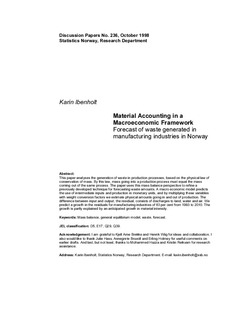| dc.contributor.author | Ibenholt, Karin | |
| dc.date.accessioned | 2012-02-07T21:22:55Z | |
| dc.date.available | 2012-02-07T21:22:55Z | |
| dc.date.issued | 1998 | |
| dc.identifier.issn | 1892-753x | |
| dc.identifier.uri | http://hdl.handle.net/11250/180391 | |
| dc.description.abstract | This paper analyses the generation of waste in production processes, based on the physical law of conservation of mass. By this law, mass going into a production process must equal the mass coming out of the same process. The paper uses this mass balance perspective to refine a previously developed technique for forecasting waste amounts. A macro economic model predicts the use of intermediate inputs and production in monetary units, and by multiplying these variables with weight conversion factors we estimate physical amounts going in and out of production. The difference between input and output, the residual, consists of discharges to land, water and air. We predict a growth in the residuals for manufacturing industries of 83 per cent from 1993 to 2010. The growth is partly explained by an anticipated growth in material intensity.
Keywords: Mass balance, general equilibrium model, waste, forecast | no_NO |
| dc.language.iso | eng | no_NO |
| dc.publisher | Statistics Norway, Research Department | no_NO |
| dc.relation.ispartofseries | Discussion Papers;No. 236 | |
| dc.subject | Waste | no_NO |
| dc.subject | Forecast | no_NO |
| dc.subject | General equilibrium model | no_NO |
| dc.subject | Manufacturing | no_NO |
| dc.subject | Norway | no_NO |
| dc.subject | Production processes | no_NO |
| dc.subject | JEL classification: D5 | no_NO |
| dc.subject | JEL classification: E17 | no_NO |
| dc.subject | JEL classification: Q29 | no_NO |
| dc.subject | JEL classification: Q39 | no_NO |
| dc.title | Material accounting in a macroeconomic framework forecast of waste generated in manufacturing industries in Norway | no_NO |
| dc.type | Working paper | no_NO |
| dc.subject.nsi | VDP::Social science: 200::Economics: 210::Economics: 212 | no_NO |
| dc.source.pagenumber | 27 s. | no_NO |
